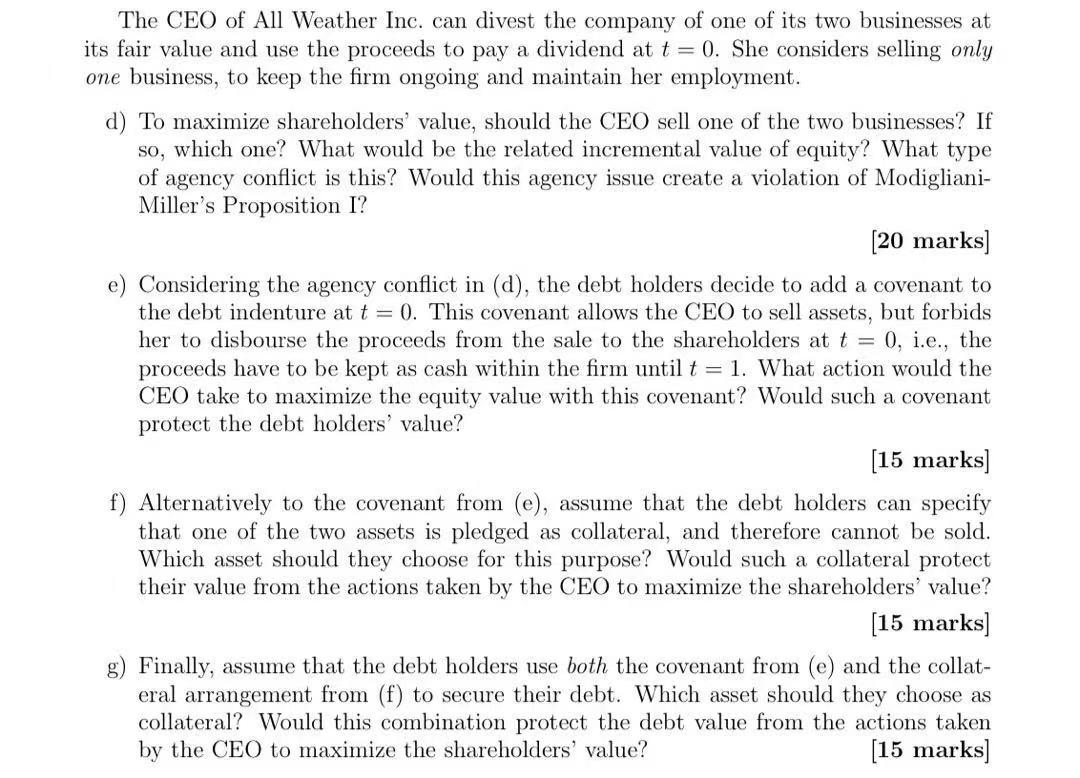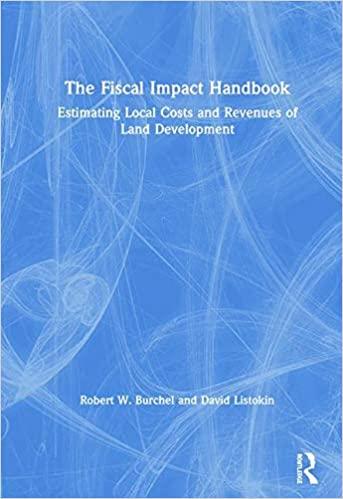

A UK company, All Weather Plc., has two assets in place at t = 0. The first is a sunglasses business, the second asset is an umbrella business. The company has debt maturing in one year (t 1) with face value of 1200 and coupon rate equal to the risk-free rate. During the year, two states of nature may prevail: sunny (S) and rainy (R), and because this is how Britain is, the probability of S is only 0.4. The current risk-free rate is 0% and the market risk premium is 10%. Thereafter, sums are in million. At t = 1, the sunglasses business generates cash flows of 1000 in S and 500 in R, and the umbrella business generates cash flows of 500 in S and 1000 in R. At t = 0, the asset betas for sunglasses and umbrella businesses are 0.7692 and -0.5882, respectively. The CEO of All Weather Inc. can divest the company of one of its two businesses at its fair value and use the proceeds to pay a dividend at t = 0. She considers selling only one business, to keep the firm ongoing and maintain her employment. d) To maximize shareholders' value, should the CEO sell one of the two businesses? If so, which one? What would be the related incremental value of equity? What type of agency conflict is this? Would this agency issue create a violation of Modigliani- Miller's Proposition I? [20 marks] e) Considering the agency conflict in (d), the debt holders decide to add a covenant to the debt indenture at t = 0. This covenant allows the CEO to sell assets, but forbids her to disbourse the proceeds from the sale to the shareholders at t = 0, i.e., the proceeds have to be kept as cash within the firm until t = 1. What action would the CEO take to maximize the equity value with this covenant? Would such a covenant protect the debt holders' value? [15 marks] f) Alternatively to the covenant from (e), assume that the debt holders can specify that one of the two assets is pledged as collateral, and therefore cannot be sold. Which asset should they choose for this purpose? Would such a collateral protect their value from the actions taken by the CEO to maximize the shareholders' value? [15 marks] Finally, assume that the debt holders use both the covenant from (e) and the collat- eral arrangement from (f) to secure their debt. Which asset should they choose as collateral? Would this combination protect the debt value from the actions taken by the CEO to maximize the shareholders' value? [15 marks] A UK company, All Weather Plc., has two assets in place at t = 0. The first is a sunglasses business, the second asset is an umbrella business. The company has debt maturing in one year (t 1) with face value of 1200 and coupon rate equal to the risk-free rate. During the year, two states of nature may prevail: sunny (S) and rainy (R), and because this is how Britain is, the probability of S is only 0.4. The current risk-free rate is 0% and the market risk premium is 10%. Thereafter, sums are in million. At t = 1, the sunglasses business generates cash flows of 1000 in S and 500 in R, and the umbrella business generates cash flows of 500 in S and 1000 in R. At t = 0, the asset betas for sunglasses and umbrella businesses are 0.7692 and -0.5882, respectively. The CEO of All Weather Inc. can divest the company of one of its two businesses at its fair value and use the proceeds to pay a dividend at t = 0. She considers selling only one business, to keep the firm ongoing and maintain her employment. d) To maximize shareholders' value, should the CEO sell one of the two businesses? If so, which one? What would be the related incremental value of equity? What type of agency conflict is this? Would this agency issue create a violation of Modigliani- Miller's Proposition I? [20 marks] e) Considering the agency conflict in (d), the debt holders decide to add a covenant to the debt indenture at t = 0. This covenant allows the CEO to sell assets, but forbids her to disbourse the proceeds from the sale to the shareholders at t = 0, i.e., the proceeds have to be kept as cash within the firm until t = 1. What action would the CEO take to maximize the equity value with this covenant? Would such a covenant protect the debt holders' value? [15 marks] f) Alternatively to the covenant from (e), assume that the debt holders can specify that one of the two assets is pledged as collateral, and therefore cannot be sold. Which asset should they choose for this purpose? Would such a collateral protect their value from the actions taken by the CEO to maximize the shareholders' value? [15 marks] Finally, assume that the debt holders use both the covenant from (e) and the collat- eral arrangement from (f) to secure their debt. Which asset should they choose as collateral? Would this combination protect the debt value from the actions taken by the CEO to maximize the shareholders' value? [15 marks]








